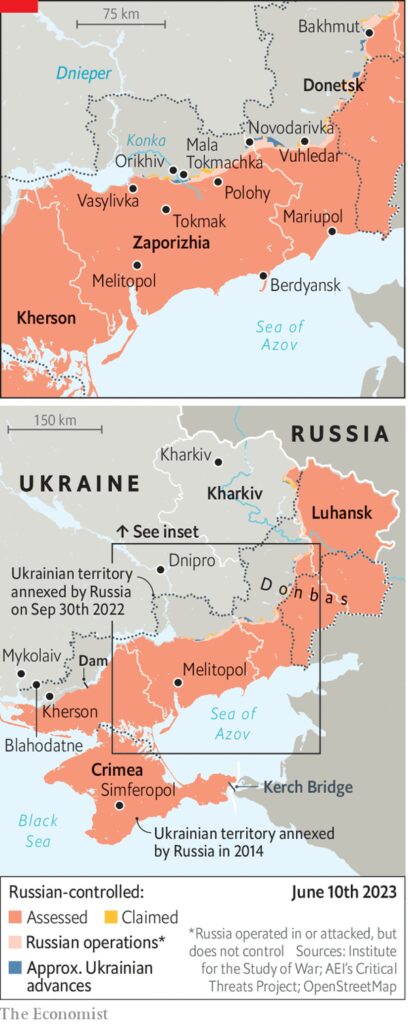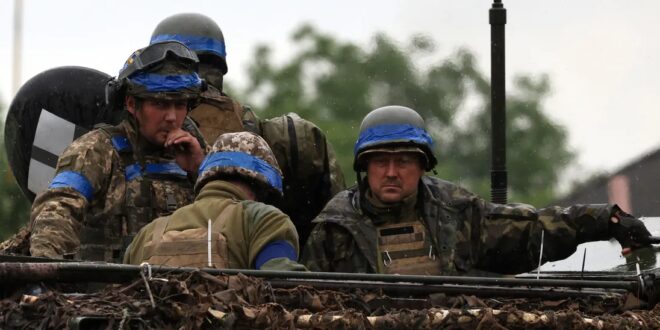UKRAINE IS JUST a week into its counter-offensive against the Russians, but already the reports from the frontlines range from upbeat to gloomy. On June 11th its 68th brigade reported that it had liberated Blahodatne, a village in Donetsk province, 10km inside Russian-occupied territory. Russian military bloggers suggested that the raid had gone much deeper still, and taken in other nearby villages. There was some progress made near Bakhmut further north-east, too, with Ukrainians advancing to encircle the devastated town that has been the only real focus of Russia’s offensive efforts for the past year.
That progress contrasted with less encouraging news from another counter-offensive operation taking place further south and west, in the Zaporizhia region. Full-frontal fighting along the Orikhiv-Tokmak axis there has been hard going, a military source conceded, with Ukraine taking significant losses of armour and personnel. “More than dozens” of soldiers had fallen, he said. Ukraine had attacked using its well-equipped 47th brigade, but has struggled to cope with Russia’s traditional strengths in building fortifications and in electronic warfare, a source in Ukraine’s military intelligence added.

The full shape of Ukraine’s plans is yet to become clear. The scale of the deployment along the Tokmak axis—and the town’s strategic role as both a rail hub and a gateway to strike at the Russian main road to Crimea—suggested at one point that it might grow into a main push. But a source in Ukraine’s general staff urged caution. “We haven’t committed our main forces, and the Russians haven’t committed their main forces.” Both were involved in a “chess game” to draw out each others’ reserves, he said. Ukraine’s “immediate priority” is reducing Russian superiority in artillery, by targeting its systems with long-range fire. Footage from far behind the frontline suggests that they have already achieved some success.
The role of aviation, where Russia enjoys a clear advantage on paper, is key. More of it is now being used in the Zaporizhia sector than has been deployed at any time since the opening stages of the war. But Ukrainian sources suggest that Russian pilots remain risk averse and fearful of Ukrainian air defences. These have been bolstered by mobile Western guns like the Gepard, as well as re-commissioned Pantsir missile systems abandoned by the Russians during Ukraine’s counter-offensive in the Kharkiv region in the autumn.
Where Russian forces are pushing harder is with drones—from reconnaissance to strike drones. Denys Yaroslavsky, a special-forces officer now fighting in a village north of Bakhmut, reports a massive increase in the use of such devices in that theatre. Apart from Lancet strike drones, capable of destroying tanks and artillery systems, Russian forces have acquired significant numbers of Chinese drones, he says. (Western sources are yet to observe any large-scale arms transfer).
Mr Yaroslavsky is confident that Ukraine will continue to close the circle around Bakhmut. “It’s hard going, but we are moving constantly. Within a week we will have the high ground…and Bakhmut in the palm of our hands.” Serhiy Cherevaty, the spokesman for Ukraine’s eastern group of forces, said Ukrainian troops were advancing by anything from several hundred metres to two kilometres a day, a far higher rate of advance than that of Russia over the past year. A breakthrough in Bakhmut would certainly be an embarrassment for Russia, which has invested heavily in taking the town. But what Ukraine intends to do from there is unclear.
As Russian planners ponder the possibility of yet another direction of attack, one unexpected variable could be the situation in the flooded plains of Kherson. The partial collapse of the Nova Kakhovka dam on June 6th created a humanitarian disaster. But it also upended Ukrainian military plans. The destruction of the bridge alongside the dam has almost certainly put an end to any crossing of heavy weaponry. That said, Ukrainian military sources hint at a different type of operation. Flooding has washed away Russian defences on the eastern side of the Dnieper, one said; and that has created opportunities. “The conditions are arguably better for a limited assault using speedboats and special forces,” one said.
Andriy Zagorodnyuk, a former defence minister, says that Ukraine’s military leaders are probably keeping things ambiguous on purpose. “Eventually [the counter-offensive] will become more focused, but the early approach might be more opportunistic and scattered,” he said. Nature could also play a part. Rain is predicted for much of the next week, which could stall some of Ukraine’s advances, while also making Russian air operations and reconnaissance more difficult. Ukraine will only go as fast as the conditions allow, an intelligence source said. “We need to hurry, but slowly.”
 Eurasia Press & News
Eurasia Press & News



